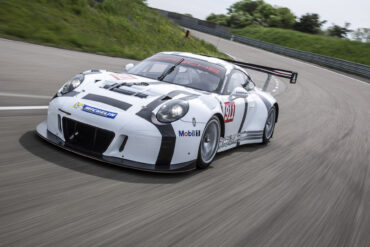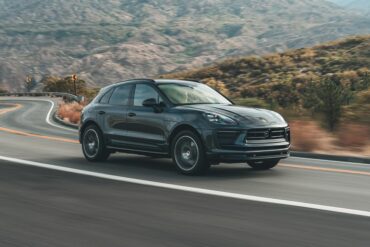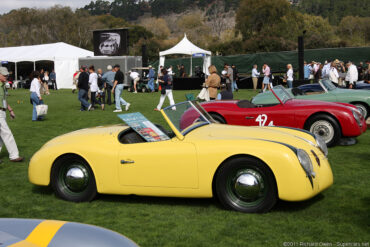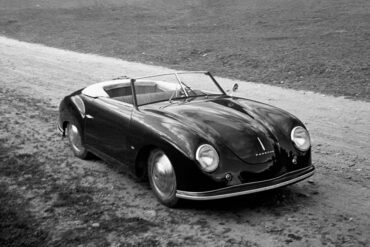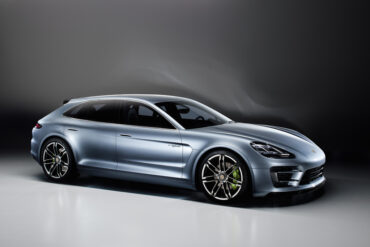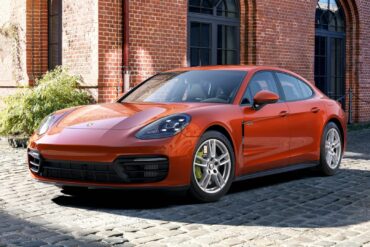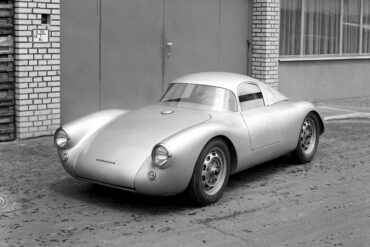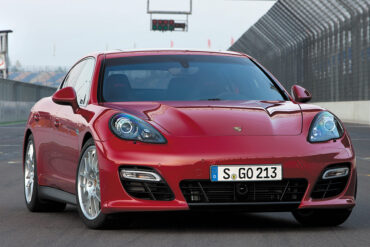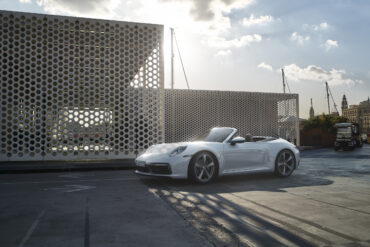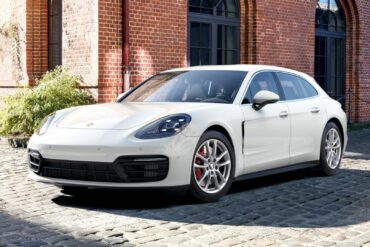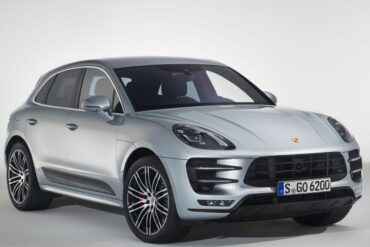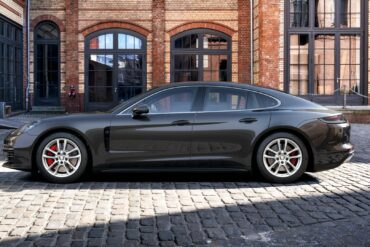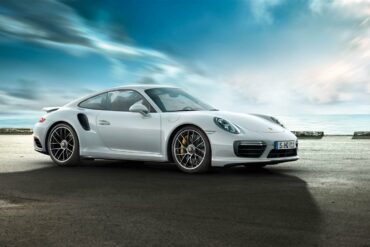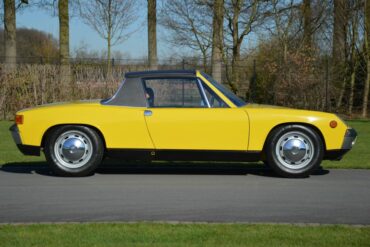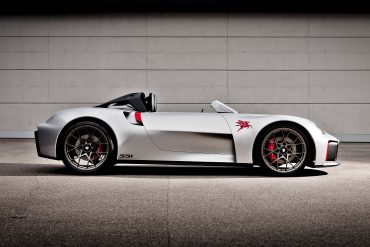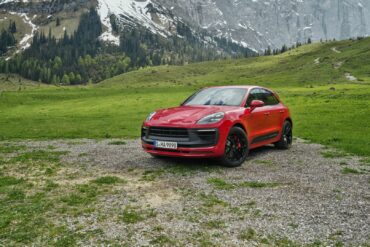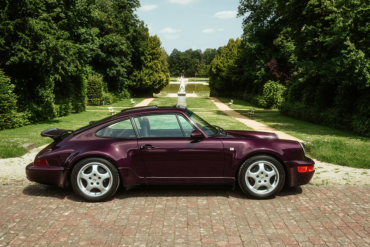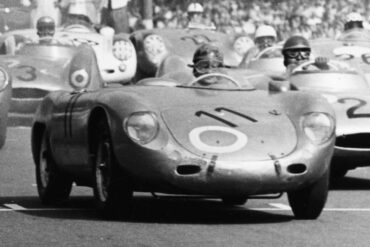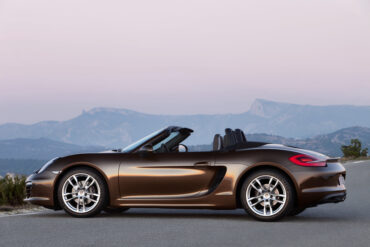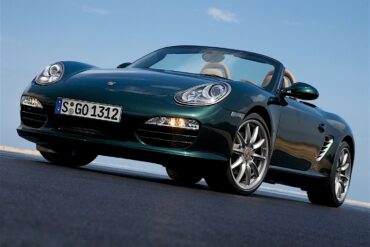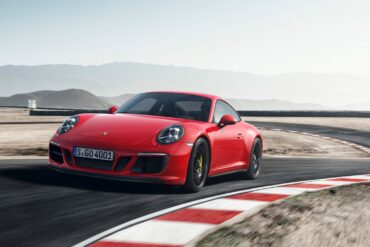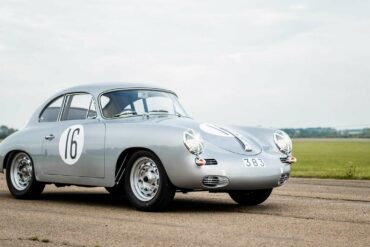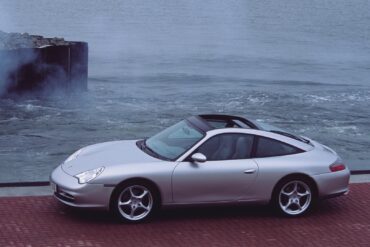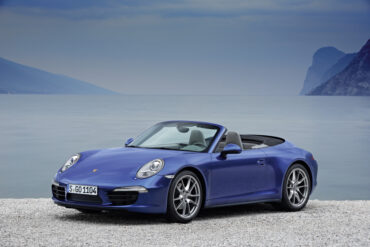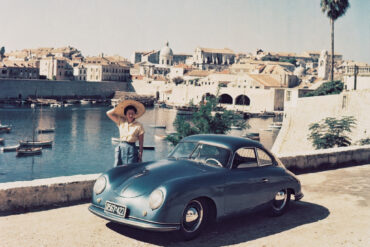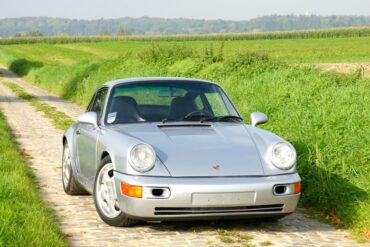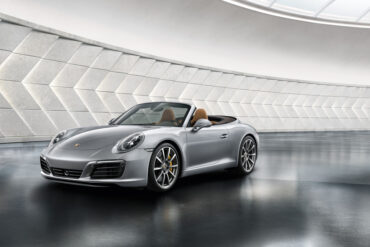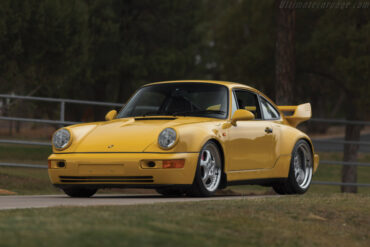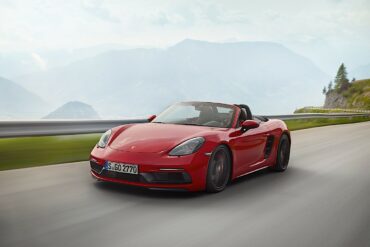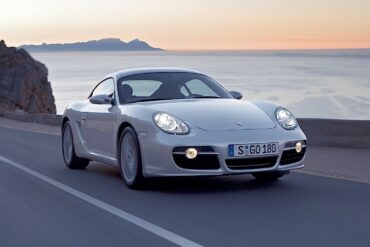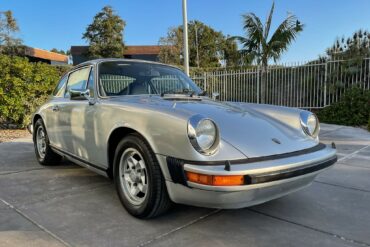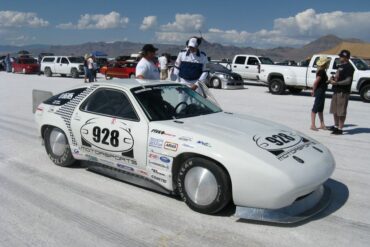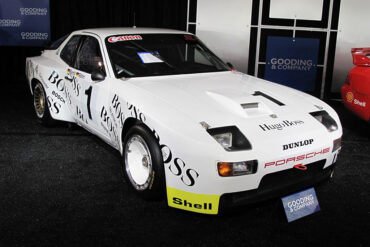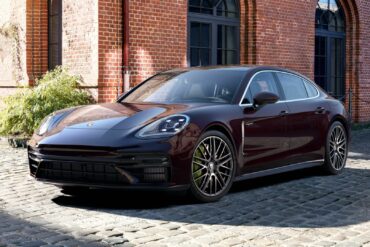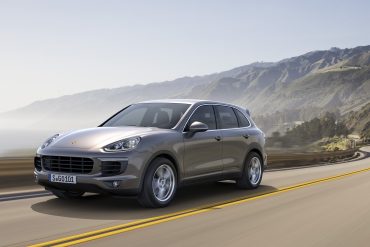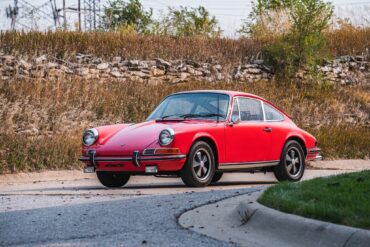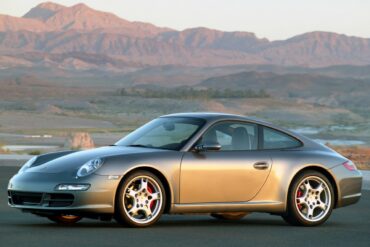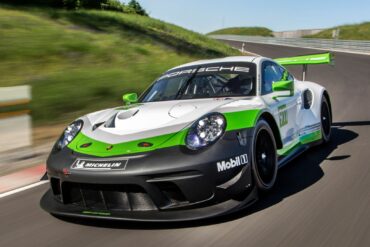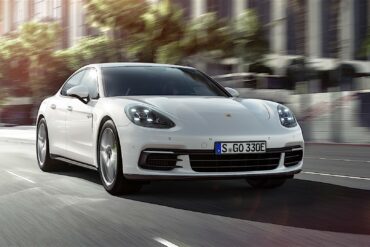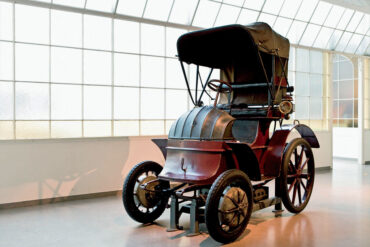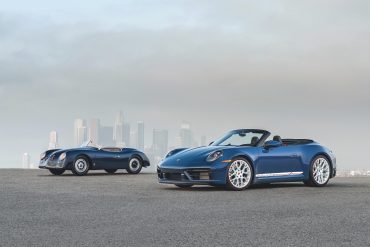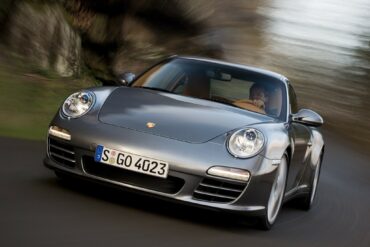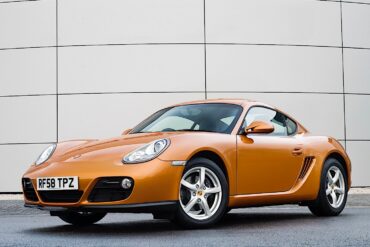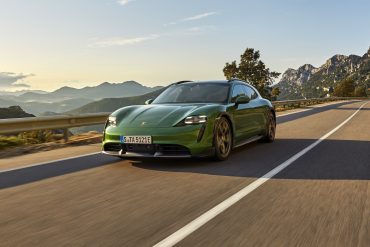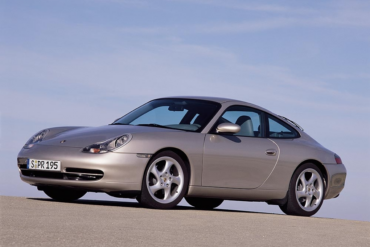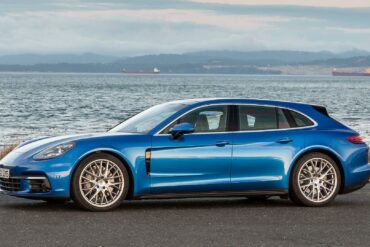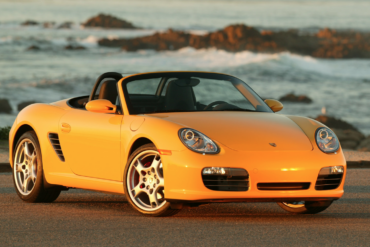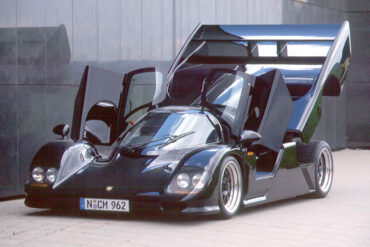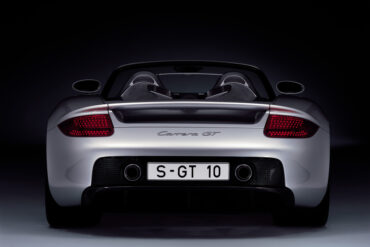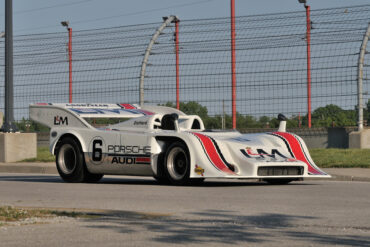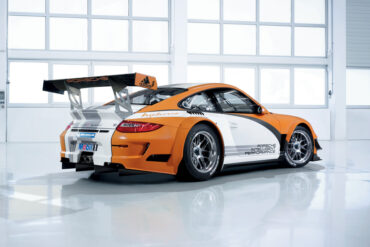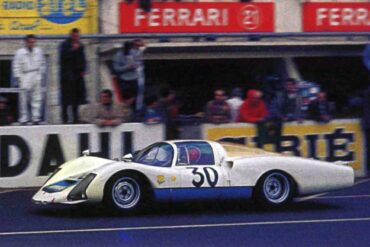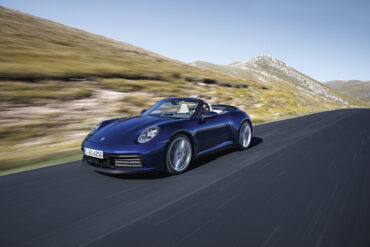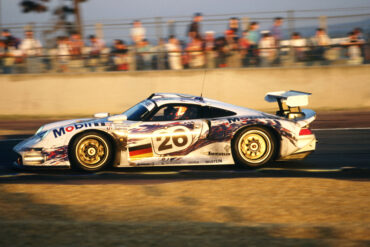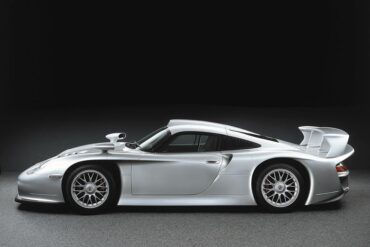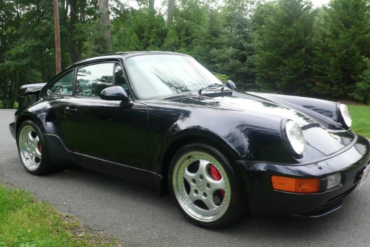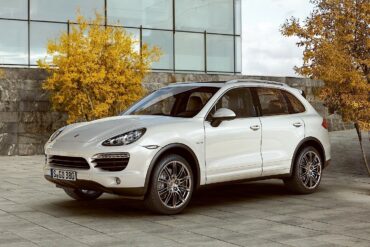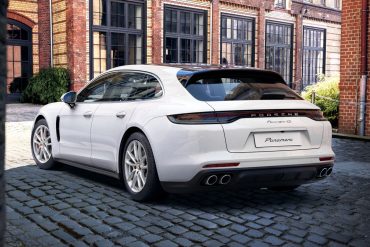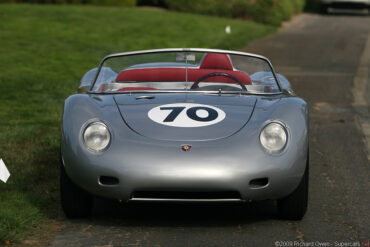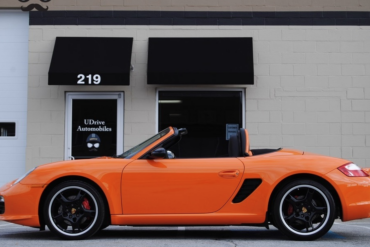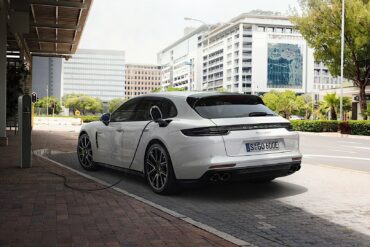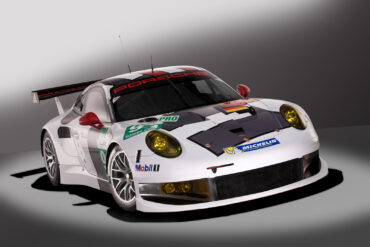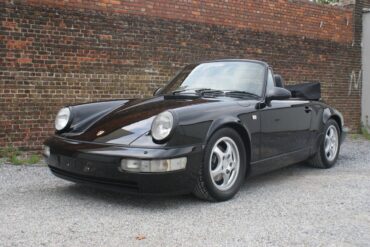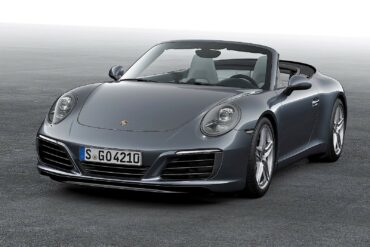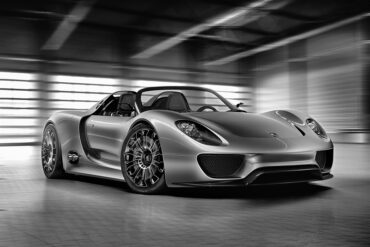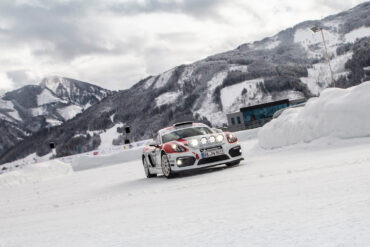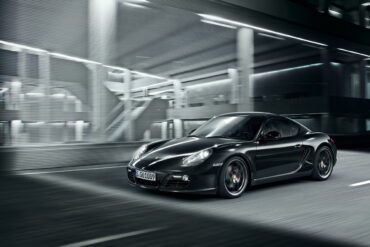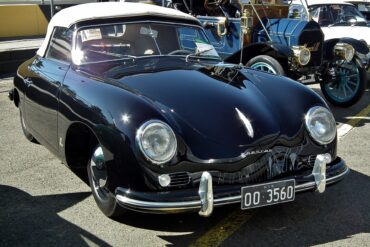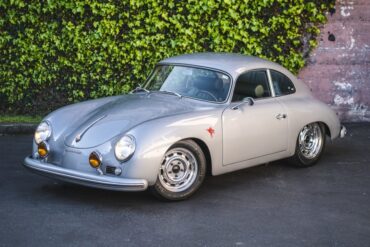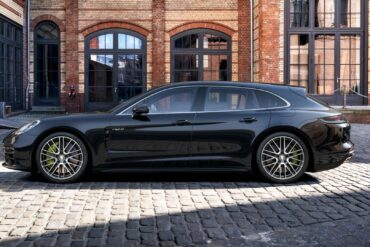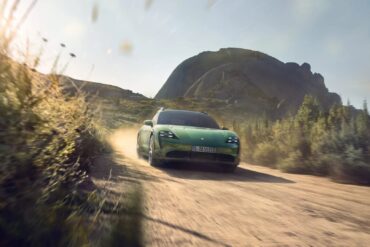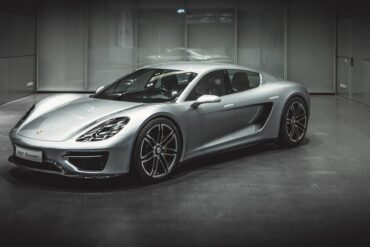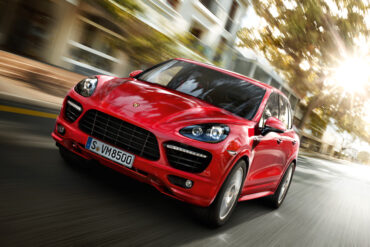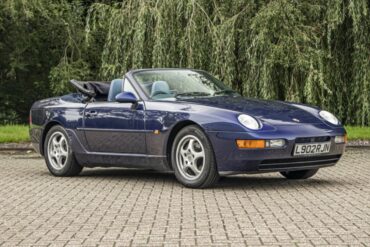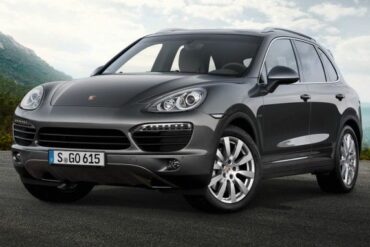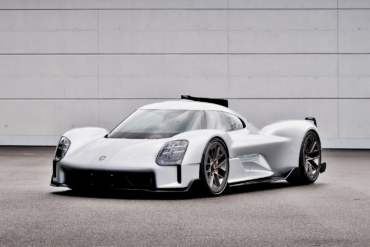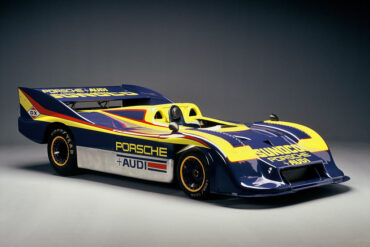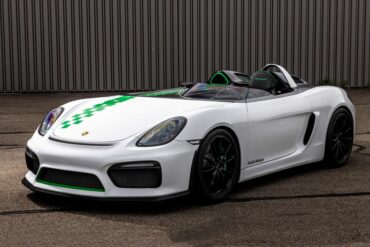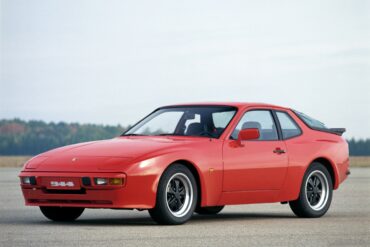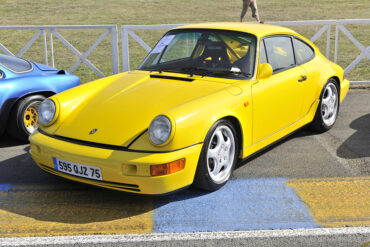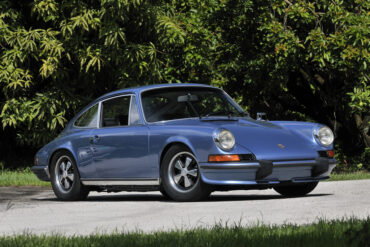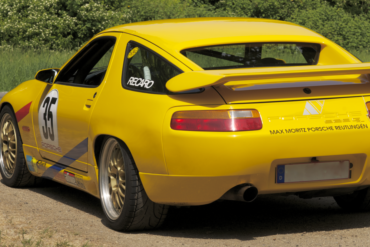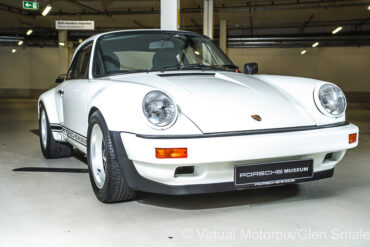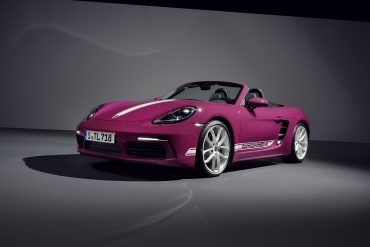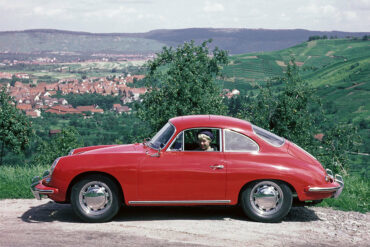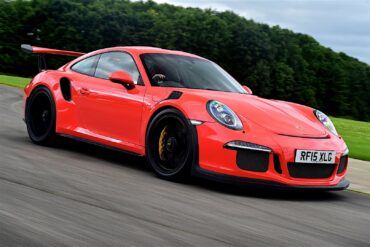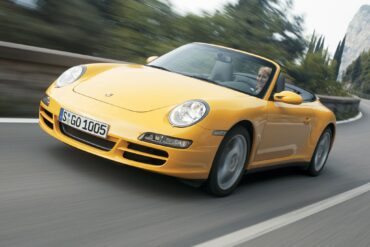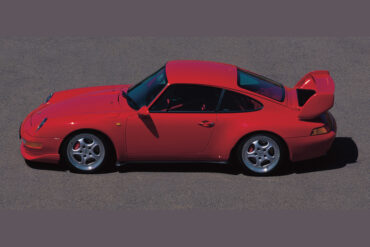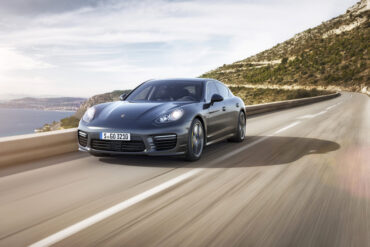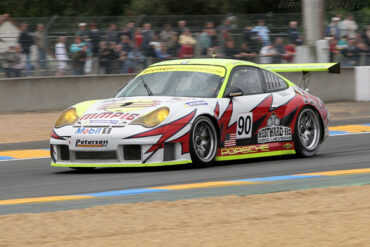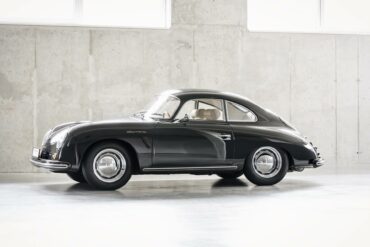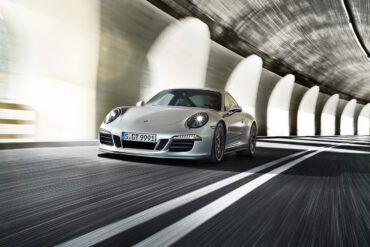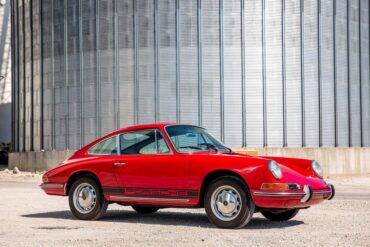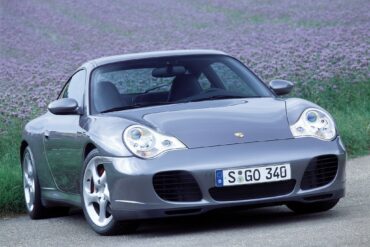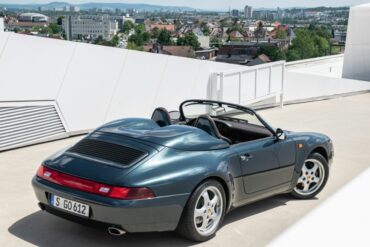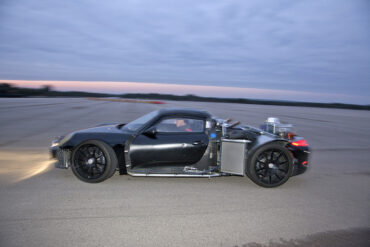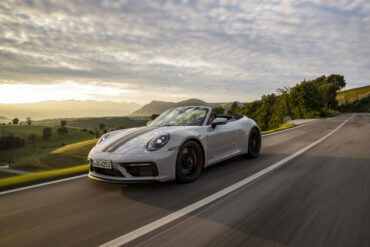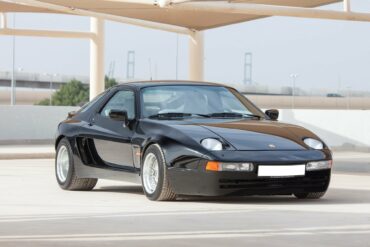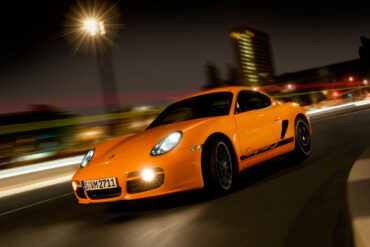Based on the 911 GT3 RS production sports car, Porsche has designed a customer sport race car for GT3 series around the world: The 911 GT3 R. In developing the more than 368 kW (500 hp) racing nine-eleven, special attention was paid to lightweight design, better aerodynamic efficiency, reducing consumption, improved handling and optimised safety. The 911 GT3 R features the distinctive double-bubble roof, and the wheelbase which had been lengthened compared to the prior generation.
Porsche introduced yet another facelift for the Macan lineup for the 2022 model year. The range got more power under the hood, a refreshed design, and an improved interior. The base turbocharged 2.0-liter four-cylinder now makes 261 horsepower. It is a newly developed, turbocharged four-cylinder engine that helps hustle the base Macan from 0 - 60 mph in just 6.2 seconds and reaches a top speed of 144 mph. The redesign on the outside gives the base 2022 Macan a tighter look.
This isn't technically a Speedster, but the Type 540 (Typ 540 K/9-1 to be very precise) - known more commonly as the America Roadster - started the idea. The American Roadster was the direct predecessor of the Speedster. U.S. importer Max Hoffman convinced Porsche it needed a lightweight convertible to compete. It only had an emergency folding roof and could keep up with larger sports cars of the era. But the production methods used to create the America Roadster’s aluminum body proved to be too expensive, and in 1952 Porsche built only 21 units before its discontinuation in 1953.
Of the 52 cars made in Gmünd, only eight were built up as cabriolets. Each was outsourced for its body and interior construction. Six cars were sent to Beutler who constructed them with a slightly different shape than the factory coupes. Included was a kicked-up rear fender line which was used on several of the Buetler cabriolets.
Porsche is presenting the Panamera Sport Turismo concept car to show how amazingly intelligent and efficient drive technology might look in the design language of tomorrow. The Sport Turismo unites the next generation hybrid drive with new ideas for an evolutionary, sporty body concept; it combines Porsche performance with comprehensive everyday practicality.
The Panamera 4 E-Hybrid still gets the 2.9-litre V6 - from the non-hybrid variant - that's good for 325 hp and 331 lb-ft of torque. In addition to that, there's an electric motor and battery combo that supply an extra 134 hp and 295 lb-ft of torque. In all, the Panamera 4 E-Hybrid boasts a maximum combined output of 455 hp and 516 lb-ft of torque, pushing the car well into sports car territory. The car weighs almost 5,000 lbs but will still accelerate to 60 mph in an impressive 4.2 seconds with the Sport Chrono Package.
One year before Porsche started production of the legendary RS Spyder, they experimented several unique 550 Prototypes. Two of these were fitted with removable hardtops that transformed the diminutive roadster into a sleek coupe. These were quite successful on faster circuits, but the roadster was later preferred as a more saleable car. The Coupes were retained by the factory to contest the Carrera Panamericana race.
The Panamera GTS was more like a detuned Turbo than an upgraded 4S. Its outside look was on a par with the Panamera Turbo, with large air intakes on the front and standard front section from the SportDesign package, that emphasized the sporty dynamics. On the front, the bi-xenon headlights had black inner bezels and featured four LED daytime running lights. In the rear, there was the same adaptive spoiler that deployed at speeds above 205 kph (121 mph).
Features like Porsche’s active suspension and the new-for-992 “wet mode” are standard on the Carrera 4 variants, but the electronically controlled limited slip rear differential (standard on the 4S), as well as ceramic composite brakes (cast iron rotors are standard). The current 911 Carrera 4 Cabriolet is equipped with PASM (Porsche Active Suspension Management). The twin-turbo flat-six has 379 hp and 331 ft lbs of torque.
The Panamera 4 Sport Turismo favours a 'Shooting Brake' style rather than being a pure wagon. This is evidenced by its sloping roofline towards the rear, sacrificing cargo space for a more stealthy profile. In addition, there's the pronounced shoulder and elongated window line, which lend the vehicle its striking appearance. The car slots in just above the base Panamera in a lineup that includes up to twenty-five different variants. The '4' references the standard all-wheel-drive, while the 'Sport Turismo' badging hints at more power and agile handling compared to the base trims.
The top model in the Porsche Macan lineup is the Macan Turbo and in 2017 Porsche made it extra special by offering a Performance Package add on. After the performance enhancement, the twin-turbocharged, 3.6-litre V6 engine delivers 324 kW (440 hp; combined fuel consumption 9.7–9.4 l/100 km; CO2 emissions 224–217 g/km). With 30 kW (40 hp) more than the Macan Turbo, this figure places this variant firmly in the top spot in this model line. The car now accelerates from zero to 100 km/h in just 4.4 seconds
The Panamera 4 is the first model in the Panamera lineup to feature all-wheel-drive (evidenced by the '4' badging). A few steps above sits the Panamera 4S, a sedan that offers more oomph in performance. After all, that is why Porsche added the 'S' for 'Sport' to the name. It all starts with the engine. The twin-turbocharged V6 has been upgraded and now puts out 443 hp and 405 lb-ft of torque. That's a significant increase from the 325 hp and 331 lb-ft of torque offered in the base Panamera 4.
With the Turbo S, the PDCC Porsche Dynamic Chassis Control hydraulic roll bars came as standard. The PCCB Porsche Ceramic Composite Brakes had been standard on the Turbo S already since the 996 generation. New options included the radar-based lane change assist and a lift system for the front axle (increased ground clearance by 1.6″/40 mm). The PCM now had a multi-touch screen like in the facelifted 991 Carrera. Routes and places could be visualized with 360-degree images and satellite images. Engine gets more horsepower too, now with 572 bhp and 553 ft lbs of torque.
The Porsche 914 was first shown at the 1969 Frankfurt Auto Show was, as intended, a true conglomeration. The front suspension was largely derived from the 911 with some VW components, and the interior was a blend of both companies' parts bins. The initial engine offering was Volkswagen's 80-hp fuel-injected 1.7 liter flat four, while the 914/6 had a twin-carburetor 2.0-liter Porsche flat six tuned for 125 hp.
The 551 Vision Spyder was built in 2019 but kept a secret until its unveiling this week. Billed as a 21st century reimagining of the 1954 machine that made Porsche’s name, in fact it’s really an hommage to one particular car, James Dean’s Little Bastard, wearing the race number 131 (Dean’s was 130) and the licence tag “Little Rebel”.
The 2022 GTS get the same engine that powered last year's Turbo model, a twin-turbocharged 2.9-liter V-6 rated for 434 horsepower and 405 lb-ft of torque, which amount to increases of 59 horses and 22 lb-ft over the previous GTS. All Macans also come standard with a seven-speed dual-clutch automatic transmission and all-wheel drive, which combine to push the GTS into the "genuinely fun" category of athleticism and should help it mimic the Turbo's 3.5-second sprint to 60 mph.
In March 1993, Porsche presented the Porsche 911 anniversary model “30 years 911” at the Geneva Motor Show. Since then, the special model is also called “Jubi” for short. Under the Porsche internal code M096, there is essentially a Carrera 4 with the wide turbo body but without wings. The 964 anniversary edition could be ordered with exclusive interior design and numerous possibilities of customization. According to Porsche, the special model was limited to 911 vehicles and manufactured in the model years 1993 and 1994.
Planned as a successor to the Porsche 550. A one off prototype was the 1956 super-light design utilising one of the spare 550 frames – 550-098 called ‘Mickey Maus’ which, with Richard von Frankenberg at the wheel, was reduced to a melted wreck that same year in a spectacular crash at the Avus race track. Known as Type 645, it was the beginnings of the new Type 718 Porsche with a shorter wheel base and unique suspension.
The third generation Boxster was a bigger car than the 987 it replaced, but it was also lighter and more powerful. The 2013 model year Boxster went through a downsize program and received a 2.7-liter boxer engine, which was 0.2-liter smaller than its predecessor. With 261 bhp @ 6700 rpm and 206 ft lbs @ 4500 rpm the base Boxster still felt underpowered to many. The base 981 Boxster got a 6-speed manual gearbox or you could opt for an optional 7-speed reworked PDK. The base car is plenty fast but if it were our money, we would opt for the more powerful Boxster S.
In 2008, the second generation of the Boxster received new technologies and more power. It reached almost the same power as the former Boxster S, from the first generation. The 2.9-liter unit replaced the older 2.7-liter engine and offered 10 hp more than the older engine. It was paired as standard to a 6-speed manual, and a 7-speed PDK (Porsche dual-clutch) automatic was available as an option. The outside gets some welcome design tweaks also, while on the inside we get some updates and more technology options.
The GTS coupe starts with the wider Carrera 4 body, with the rear fenders pushed out 1.7 inches, and the rear track widened 1.6in. Up front is the new SportDesign front fascia with its lower front spoiler and larger cooling air intakes. Standard wheels are 20-inch center lock items and 0.5 inch wider than standard Carrera S rims, finished in satin black. There are splashes of black elsewhere, too. The changes run more than skin deep. Bigger turbos pump up to 18psi of boost pressure which helps deliver not only 30 extra horses at 6,500 rpm, but 405 lb-ft of torque between 2,150 rpm and 5,000 rpm, up from 368 lb-ft. This is the sweet spot.
While all 356 Carreras are rare and desirable cars, the 1961 B Carrera GT is a very special animal indeed. Built from lightweight materials and sporting Porsche’s most powerful racing engine of the time, they were in a different league to the most highly specified road car that the Stuttgart factory then produced. Porsche produced only 49 of the 356B Carrera versions for 1960/61 and all were coupes. Many were painted Silver.
In 2002, the standard Carrera models underwent a facelift. In addition, engine capacity was also increased to 3.6-litres across the range, with power up slightly on the naturally aspirated models. 2002 also marked the start of the production of the 996 based Targa model, with a sliding glass "green house" roof system as introduced on its predecessor. It also features a rear glass hatch which gave the driver access to the storage compartment. The 996 Targa is the rarest bodystyle in the series – only 5,152 were produced (all Mk.2 generation) between 2002 and 2005.
The new Porsche 911 Carrera 4 unites the excellent performance and efficiency of the new generation of the 911 Carrera with the dynamic benefits of the latest version of the active all-wheel drive system PTM (Porsche Traction Management). The typical Porsche all-wheel drive with rear-focused layout in this latest 911 version guarantees maximum vehicle dynamics on a wide variety of road surfaces and in all weather conditions. The new 911 Carrera 4 models deliver traction and dynamic performance the power of four.
The series production didn't allow the use of handmade aluminium body panels, so, the cars were made of stamped steel panels. The first Stuttgart-built 356 have later been called as 356 Pre-A. These cars have either two separate windscreen glasses like the 356 built in Austria, or a sharply bent windscreen glass! Introduced in 1948, the Porsche 356 Pre-A Coupe was the first variant available for the Porsche 356. The engine started as a 1100 cc flat four that produced 40 hp. It was available as a coupe and cabriolet body style.
The 964 Carrera RS (Standard) was introduced by Porsche for model year 1992 specifically for the European market as a lightweight, high performance version of the 964 Carrera 2. It featured a revised version of the standard 3.6 liter engine, titled M64/03 internally, with an increased power output of 260 bhp (194 kW; 264 PS). The RS does not look much different from the other 911 models of the period but its weight is reduced and power increased. True to its racing spirit, the Carrera RS featured bucket seats and thinner materials, but lacked power windows, air conditioning, air bags, and other creature comforts.
The switch to turbocharging delivers predictably faster acceleration, with 0 - 60 mph taking just 3.9 seconds with the PDK transmission and Sport Chrono optioned. The quarter mile is dispatched in 12.2 seconds and the top speed for the open top Carrera S is 190 mph. These numbers are pretty impressive for an open top 911 that is just as comfortable driving around town as it is on back roads on spirited runs. With the 991.2 Carrera S Cab, it can be argued that there is no real need dynamically to opt for. the coupe body. A great overall sports car that is fast, fun and happens to have no roof.
The 964 Carrera RS 3.8 was produced as a base for homologation for the venerable 3.8 RSR. It was unveiled in 1993 and produced in a very small series by Porsche’s Racing Department in Weissach-Flacht, and was an extreme evolution of the 964 Carrera RS that was released two years prior. It featured the wide-body look of the Type 964 Turbo, a massive rear spoiler, and three-piece “Speedline for Porsche” wheels with 235/40 and 285/35 tires, making it distinctively more aggressive in appearance than the fairly restrained styling of the Carrera RS of 1992 and capable of providing significantly more mechanical grip.
In true Porsche GTS spirit, the output of the 2.5-litre, four-cylinder flat ‘boxer’ engine has been increased to 360 bhp courtesy of a new intake system and an optimized turbocharger. These improvements generate 15bhp more power compared with the 718 S model, and up to 35 bhp more power than the prior GTS models. A manual six-speed gearbox is standard, with the Porsche PDK available as an option. Standard equipment includes the Sport Chrono Package, Porsche Torque Vectoring (PTV) with a mechanical rear axle limited slip differential and Porsche Active Suspension Management (PASM).
After the initial announcement that Porsche was going to release a small mid-engine coupe, we were all excited. In 2005 we finally got the Cayman S. A fast, mid-engine coupe in the Porsche lineup, starting with the S version as a 2006 model year car (the base model came a year later). The 2006 Porsche Cayman S was based on the Boxster series, the two-seat coupe incorporated dramatic new styling, a powerful 295 hp (SAE) engine, and features and options made popular by Porsche's current range of sports cars.
Commemorating 25 years of Porsche sports car production, the 911S Silver Anniversary Edition is distinguished by unique Diamond Silver Metallic paint and a special black leatherette and tweed interior. The first of Porsche’s commemorative ‘celebration’ cars, this Silver Anniversary was produced in a limited run of 1,063 examples, of which approximately 500 are reported to have made their way to the United States.
When it comes to land speed records speed is measured to the fifth decimal place (hundred thousandths). So when Carl Fausett’s Porsche 928 hit 216.63537 MPH, that was more than enough to capture the title of World’s Fastest Porsche 928 (previously set at 206 MPH). It happend on August 7, 1986 with Al Holbert behind the wheel.
In 1981 Porsche developed two 944 prototypes to succeed the 924 GTPs which raced the 1980 24 Hours of Le Mans. To coincide with the release of the 944 in fall of 1981, Porsche prepared a GTP version to promote the car before the launch. The GTP was equipped with a special Type 949 cylinder block with dry sump lubrication, KKK K28 turbocharger and an air-to-air intercooler.
This Porsche limousine boasts impressive performance stats like the other Turbo S E-Hybrid variants. However, a lengthened wheelbase with a bias towards rear-seat luxury is the 'cherry on the cake' that sets this one apart. The car promises a sporty package with the luxury of a limousine, and to be fair; it mostly delivers on both counts.
In July 2014, Porsche launched a facelifted Cayenne range for the 2015 model year. Minor exterior alterations and new power-train options. For the base Cayenne, there was a a mildly revised exterior and interior inspired by the 918 Spyder. Two new interior colors, Carrara White and Palladium Metallic, are new while the two-tone black/beige upholstery is now a no cost option. Dark walnut is also a new addition to the available interior accents. The suspension on all Cayennes has also been revised.
The Porsche 911 E was designed to fall nicely between the 911 T touring model and the top of range high-performance 911S. The Porsche 911 T would continue for its second year in Europe, and newly introduced into the United States market, as the entry level offering for the 911, sitting below the 1969 911E and the 1969 911S. The 1969 911E was powered by engine Type 901/09 (Type 901/11 with Sportomatic) featuring mechanical fuel injection (MFI). The 2.0 L Aircooled Flat 6 was good for 140 bhp at 6500 rpm.
The 997 Carrera S was the first step up in performance over the base 997 Carrera. Available over two distinct generations, the 997.1 Carrera S used a 3.8-liter engine producing 355hp – the available X51 Powerkit bumped that number to 376hp. From 2009 onwards, the 997.2 Carrera S offered 380hp from 3.8 liters. Besides a more powerful engine, it also comes standard with 19 inch wheels, larger brakes, and a lowered suspension with PASM.
The GT3 R has always been placed between the GT3 Cup and the very expensive RSR. All the 991.2 racing cars have normally aspirated 4-litre engines. Compared to the 991.1 GT3 R, the 991.2 GT3 R engine offers a broader usable rev range and the engine response is more precise due to 6 throttle butterflies. The roof, front hood and fairing, wheel arches, doors, side and tail sections, rear lid and interior trim are made of carbon-fibre reinforced plastic. Gets new double wishbone suspension.
The fourth model of the Panamera was introduced at the 2016 Paris Motor Show. It was the enhanced plug-in hybrid version, named 4 E-Hybrid. It was the first all-wheel-drive Panamera hybrid. It was fitted with a more powerful electric motor and a twin-turbo 2.9-liter V6 gasoline engine. The powerplant was fitted to an 8-speed automatic gearbox. Its predecessors were fitted with rear-wheel-drive only. The Panamera 4 E-hybrid always started in electric mode and turned on its gasoline unit later.
1900 Lohner-Porsche Hybrid With its future-oriented electric motors in the wheel hubs, the Lohner-Porsche was acknowledged as the absolute sensation...
If you're not one for celebrating special models that don't improve performance, this 2023 Porsche 911 Carrera GTS Cabriolet America will be right up your alley. Porsche has gone beyond just slapping on some new paint, unique trim, and special wheels. There is some performance to go along with the history behind the America name-plated Porsche, besides the incredibly long name.
Most importantly, the refreshed Carrera 4 and 4S lose the old multi-plate, viscous all-wheel-drive system in favor of the electronically controlled system from the 911 Turbo. The old system could send between 5 and 40 percent of engine torque to the front wheels once it had detected wheelspin. The new electronic system can anticipate traction losses and shift up to 100 percent of engine torque fore or aft. Porsche says the new AWD system reacts faster to traction changes, and doesn’t make the Carrera 4 significantly heavier.
Four years after the introduction of the Cayman S, and three after the regular Cayman, the mid-engine sport-coupe from Porsche received an important update. The facelifted version of the Cayman offered a completely enhanced package. From the exterior to the interior, from the engine to the gearbox and suspension, it was reworked. It might be mistaken with a new model if the Porsche internal coding system wouldn't be the same as on the 2006 Cayman (987C). The engine displacement was increased from 2.7 to 2.9-liter and received direct fuel injection.
With 750-horsepower, launch control and gravel mode in a family-friendly wagon, this may be the most practical car on the planet. Take the screaming fast all-electric Taycan Turbo S—the fastest, most powerful version atop the Taycan range—and make it a wagon with a little more ground clearance (0.78 inches) and more headroom (3.62 inches) in the rear seats, and you have the Taycan Turbo S Cross Turismo. The all-wheel-drive Taycan Turbo S Cross Turismo has one electric motor per axle, with a one-speed transmission up front and a two-speed transmission in the rear.
The 996 series was a monumental update to the 911 story. The Type 996 introduced water-cooled engines and it also ushered in a new body design. The roof line with a windscreen which is around five degrees flatter gives the side view a more fluid look. Gone was the "classic" 911 design, the entire main body now much sleeker. The flat six in the Carrera 996 was a newly-developed flat-six engine that offered 300 hp. It was mated as standard with a six-speed manual. A 5-speed automatic (Tiptronic) with manual override to shift gears was on the options list. As always, the Carrera 2 was rear-wheel-drive.
The 2017 Panamera 4S Sport Tourismo was more like a shooting-brake than a station-wagon. More like a lowered Macan than a station-wagon Panamera. Its raked rear looked like it was there to enhance the aerodynamic rather than increase the cargo area. For the powertrain, the 4s Sport Tourismo featured a twin-turbo V6 engine mated to an 8-speed automatic transmission and an all-wheel-drive system.
For the 2007 model year, the base Boxster received a revised engine featuring VarioCam Plus to provide a 3.7 kW (5.0 hp) power increase (183 kW (245 hp) the same as the Cayman). The Boxster S' engine was upgraded from 3.2-litre to 3.4-litre, resulting in a power increase of 11 kW (15 hp) more (220 kW (295 hp) the same as the Cayman S). These upgrades made the Boxster series and the Cayman series equivalent in terms of power.
Dauer 962 Le Mans (1994) In the late nineties, bringing prototype racecars to urban roadways was an idea that several...
For the 2000 Paris Motor Show, Porsche prepared a concept supercar that eventually turned into a limited production car. The concept's basic shape and specification were close the production version, which included a low-mounted V10 engine that was sourced from their scrapped Le Mans prototype program in 1999. Two functioning concepts were produced for both the European and North American show circuits.
The 1972 917/10 was similar in its design to the 908/03, but, of course, had the 12-cylinder engine instead of the 3-litre flat-8. The 917/10-72 was first seen at the Interserie Nürburgring race on April 3. It was the chassis 004 car of Leo Kinnunen and Keimola Racing Team AAW. Kinnunen scored 4th in the first race, but would win the championship by the end of the season. The second Interserie race was at Monza on May 1st and that race was won by chassis 917/10-002 and Willy Kauhsen.
During the Geneva Motor Show, a Porsche 911 GT3 R with innovative hybrid drive is making its debut. The innovative hybrid technology featured in the car has been developed especially for racing, standing out significantly in its configuration and components from conventional hybrid systems. In this case, electrical front axle drive with two electric motors developing 60 kW each supplements the 480-bhp four-litre flat-six at the rear of the 911 GT3 R Hybrid. Instead of batteries, an electrical flywheel power generator delivers energy to the electric motors.
The 906 LH was capable of achieving 174 mph/280 km/h with its 2-litre engine (906 K: 165 mph/265 km/h). At high speed the long tail started to create lift (opposite to downforce), which made the car go fast on the straight, but was dangerous to drive. At Le Mans, the 906 LHs with their experimental bodies competed in the 2-litre prototype class.
Top down summertime driving in the current 911 Carrera 4S Cabriolet is about as good as it gets. It checks all of the right boxes, as while it has matured into almost a GT-type car; it still boasts more performance than ever. Like the rest of Carrera S models, the Carrera 4S Cabriolet is powered by the same 3.0-liter twin-turbo flat-six that makes 443 horsepower and 390 ft lbs of torque. It comes standard with the same eight-speed twin-clutch automatic transmission.
In spite of its 911 moniker, the car actually had very little in common with the 911 of the time, only sharing the front and rear headlamps with the production sports car. Designed and developed to compete in the GT1 class of sportscar racing, which also required a street-legal version for homologation purposes. It was powered by a twin-turbo flat 6 that was good for 600 bhp. The 1996 911 GT1 clocked at a top speed of exactly 330 km/h (205 mph) on the legendary Mulsanne Straight.
Homologated roadgoing version of the ’97 911 GT1 Evolution racer costing $890,805 upon release. Twin-turbochargers were fitted to the M96/80 engine, which had water-cooled cylinder heads. Apparent from the front and rear lights, the GT1 shares many components with its series production counterparts, but puts them together in a more competitive way. Gone is the rear engine layout which isn't suitable for prototype GT racing, the GT1's turbocharged flat-six engine sits in front of the rear axle and is supported by chassis tubes instead of the typical 911 rear sub frame.
19 non 'slant nose' or Package cars were made for the USA only. Very rare. The Porsche factory had 93 Turbo chassis left. These were all transferred to Porsche Exclusiv and hand built as the very special 964 Turbo 3.6 S. They were offered with normal, or ‘Flachbau’ slant nose front ends. While the vast majority of Turbo S’ were fitted with the ‘Flachbau’ nose as a no-cost option, the Turbo S could also be had with the traditional 964 nose as well. In all, 76 Flatnose cars were made while 17 non-Flatnose (known as Package option) cars were made. These cars were also fitted with the X88 option, which increased power to 380 hp.
The absolute highlight of this new generation is the world debut of the Cayenne S Hybrid with its technically highly sophisticated parallel full hybrid drive and fuel consumption in the New European Driving Cycle of just 8.2 litres/100 kilometres (equal to 34.4 mpg imp), which means CO2 emissions of just 193 g/km. The Cayenne S Hybrid therefore combines the performance of an eight-cylinder with the economy of a six-cylinder running on much less fuel.
The Turismo Panamera models offer more practicality than the sedans, with the wagon body style offering valuable additional cargo space. However, there's also plenty of performance on offer. Take the Panamera 4S Sport Turismo, for example. It boasts a total of 1,384 litres with the rear seats folded, ideal for a weekend shopping trip. However, under the hood lies a potent engine in the form of a turbocharged V6 unit.
The 1961 Porsche RS was one of the last Spyders made by Porsche that used the potent 4-cam engine. It was a successor to the 1960 RS60 which was a highly developed version of the original 550 RS Spyder. These diminutive racecars excelled on the tighter courses like the Targa Florio which was first won by Porsche in 1956. That victory marked the first time a sports car with a midship engine had won a major motor sports event.
Porsche unveiled its 2008 Limited Edition Boxster and Boxster S models at a private gathering at the occasion of the 2007 New York Auto Show. Largely inspired by the 2007 911 GT3 RS, only 250 examples of each model were produced in brilliant orange. Other special exterior features included glossy black painted mirrors, alloy wheels, front and side air inlets, and model designation.
This is one practical family car with very green credentials and incredible performance. The Porsche Panamera 4 E-Hybrid was the first all-wheel-drive Panamera hybrid and in Sport Turismo body style it is more practical and dare we say it looks better too. Just like the coupé-style Porsche Panamera sports saloon, the Sport Turismo is characterized by its very dynamic proportions, which also allow it to feature three full rear seats.
As the rules do not permit higher output engines, the engine for the 991 RSR was taken from the 997 GT3 RSR 4.0 and the development work focused on the chassis, body, aerodynamics and the gearbox. A wishbone front suspension replaced the McPherson struts used in 997. A new development was the lightweight gearbox. One of the priorities in the development was the more evenly balanced weight distribution. The centre of gravity was lower, too.
The Carrera 4 model also launched with a Cabriolet version in 1989 (for 1990 model year). The new 911 generation is introduced in Autumn 1988, but the convertible was not launched until the model year 1990. Alterations to the body include the bumpers and sill tread plates, and the 911 continues to be equipped with an automatically retractable rear spoiler and a cowled underbody. The braking system is fitted with ABS. The 911 (Type 964) also features power-assisted steering for the first time. Like the Coupe, the Cabriolet got the new all-wheel drive system.
The cylinder number and position (six, horizontal) remained the same as before, but the displacement has been reduced to 3.0 liters (from 3.4 liters) and a pair of turbos has been strapped on the engine. And thanks to the force-feeding’s high potential, the same 3.0-liter unit is used for the Carrera S as well (instead of the 3.8-liter flat-six). As a result, the power figures in the Carrera 2 Cabriolet gained 20 hp and some 40 lb-ft of torque vs the prior generation. More importantly, the turbocharging makes the Carrera’s 332 foot-pounds of torque available way quicker, from just 1,700 rpm.
The 918 Spyder concept combines high-tech racing features with electric-mobility to offer a fascinating range of qualities. The highly-innovative 918 Spyder concept car combines Porsche's Intelligent Performance philosophy with the high-technology from motorsport, with classic but modern design to make a truly convincing statement.
Porsche plans to return to rally racing with a 718 Cayman GT4 Clubsport R-GT Rallye. The car came about because of the positive response Porsche received on a rally car concept that it sent out into the world. Before the official car comes, Porsche did some testing with its 718 Cayman GT4 Clubsport-based concept race car. The company let racing legend Walter Röhrl get behind the wheel at the GP Ice Race in Austria.
The Limited Edition Cayman S Black combines many of the high performance benefits found only in the 2012 Cayman R with many other desirable options off the list, options that when combined create a distinct personality for this special car. After the R hit the scene, many potential buyers complained of the inability to order one with many of the highly desirable street options, particularly PASM. The Cayman S Black Edition gets the 330 BHP engine found in the R but without all of the other performance focus.
In 1953, the 1300 S or "Super" was introduced, and the 1,100 cc engine was dropped. The 360 1300 Super boasts a power improvement to 60 BHP with Porsche's "Super" engine in the Porsche 356 model range. Minor visual differences were implemented such as front indicators integrated with the horn grilles and bumpers protrude from the body with over-riders. In June 1954, the plain-bearing 1300cc engine switched over to the same block as the 4cc larger roller-bearing variant.
From the outside, the 356A kept to the Porsche mantra of stepwise evolution. The new model was outwardly identical to the previous version except for the wider tires, a small rub-strip below the doors, a fully-curved front window and enamel paint replacing lacquer previously used. The 356 A came with an all-alloy air-cooled Flat 4 engine in four states of tune, with the 1300 having Type 506/2 engine with 44 bhp and 60 lb-ft.
The Panamera Turbo S E-Hybrid Sport Turismo is extreme indulgence at its peak. A family wagon with almost 700 hp on tap and the ability to launch hard enough to strain your back muscles. Porsche claims the car can hit 60 mph in just 3 seconds. It's impressive on its own, but even then, it seems the carmaker was being conservative as some motoring journalists were able to clock a time of 2.7 seconds. That's faster than a Ferrari 488 GTB!
When Porsche announced in 2015 with the Mission E Concept that they were deep in development of an electric vehicle...
The Porsche 960 Vision Turismo is a mid-size sedan concept, designed and built by Porsche in 2016 that previewed some of the future design cues that Porsche would incorporate into the Porsche 911 (generation 991.2). The creation of the concept happened nearly by accident when somebody saw a sketch of the 918 Spyder and thought it had four doors .
The Cayenne GTS is the hair-splitter’s latest achievement. It’s a Cayenne powered by the same 4.8-liter V-8 as seen in the Cayenne S but tuned for an additional 20 horsepower and 11 pound-feet of torque to make 420/380. It wears a body similar in style to the Cayenne Turbo, meaning a domed hood, blacked-out trim, and body-color fender extensions and side skirts. And it’s loaded with standard performance gear that is optional on lesser Cayennes. What isn't there to like?
Launched in August 1991 for the 1992 model year, the 968 was available in two body styles: a Coupe and a Cabriolet. Cabriolets came with reinforced bodyshells to compensate for the lack of a roof. Porsche quoted a weight of 1370kg for the Coupe and 1440kg for the Cabriolet. Cabriolet top speeds were slightly slower owing to their messier aerodynamics, but it was dynamically pretty impressive despite the non-coupe body.
The Cayenne S diesel earns the “S” by way of a twin-turbocharged 4.2-liter diesel V-8 engine that pumps out a prodigious 382 hp and 627 lb-ft of torque. By comparison, the non-S Cayenne diesel’s 3.0-liter V-6 spits out a relatively puny 240 hp and 406 lb-ft of twist. Interestingly, the S diesel gets Porsche’s engine stop-start system standard; here in the U.S., the fuel-saving feature isn’t available on the pedestrian Cayenne diesel.
The Porsche 919 Street is a supercar concept, designed and built by Porsche in 2017, based on the highly successful Porsche 919 Hybrid LMP1 race car. The dimensions and basic design elements of the 919 Street are the same as that of the race car. However the 919 Street instead has a less-pronounced wing and more street-car comforts. This is the one we wish they made. Alas, the 900 HP LMP1-Based road-ready rocket that never was.
The final evolution of the 917 was created after Ferdinand Piëch had left the Porsche company in 1972. Two complete 917/30 Can-Am cars with 2500 mm (98.4") wheelbase were made for Roger Penske Enterprises racing team. They were chassis 917/30-002 and 003. The 001 car was not a real 917/30 and was raced in Europe at the Interserie. The Can-Am 917/30 had a 5.4-litre flat 12-cylinder twin-turbo engine which produced so much power that nobody really knew how much.
In 2015, Porsche's executive board ordered Weissach engineers to design and build the lightest sports car possible based on the 981. It was to be more minimalistic than the 981 Spyder. Some of the inspiration came from the 1968 Porsche 909 Bergspyder. This is one sexy one-seater and roofless extreme machine. It received the 3.8-liter Cayman GT4 engine, which was tuned to produce 387hp (up 7hp). Expected Nürburgring time of around 7:30 minutes.
The base Porsche 944 coupe was built between 1982 and 1989, essentially the same platform as the Porsche 924 (there was some overlap as the 924 was produced till 1988). The 944 was intended to last into the 1990s, but major revisions planned for a 944 S3 model were eventually rolled into the Porsche 968 instead, which replaced the 944.
For race teams and track day customers Porsche prepared a small number of the 964 Cup cars according to the FIA NG-T regulations. Officially called the Competition model, these custom-ordered cars were an intermediary step between the Carrera Cup option (M001) and the standard tourer (M002). This M0003 option was available directly from Porsche as a road-going model. These cars had almost all the Carrera Cup modifications including the new suspension. This lowered the car by 40mm in the rear and 50mm in the front. It also included fitting of the larger 930 Turbo disc brakes and adjustable anti-roll bars.
The final early 911S befitted from Porsche's 2.4-liter engine the the long-wheel-base body. As such it is one of the final classic 911s before the 2.7 came out in 1973. Visually, the 2.4 range received a new chin on the front valence that was standard on the 911S and optional for the rest of the range. The S model had slight larger 6Jx15 Fuchs alloy wheels over the other models. The final early 911S benefitted from Porsche's 2.4-liter engine the the long-wheel-base body
Porsche's Racing Department never officially entered or prepared a racing 928 for a pure works entry. In order not to offend sensibilities of their traditional 911 customers by openly challenging them with a Works 928GTR offering, Porsche asked Max Moritz Racing, their longtime private racing partner from next door Reutlingen to enter a 928GTR Cup as a 'semi-works' car.
Built so that the factory Rothmans Porsche Rally Team could hit the international stage, the SC RS used the Turbo’s body with fibreglass bumpers and aluminium doors. In Autumn 1983, Porsche presents the 911 SC/RS for motor racing. The engine originates from the 911 SC, with improved performance achieved by the mechanical ball fuel injection, increased compression, the cylinder heads from the 935 and forged pistons. Racing seats are fitted in place of the standard seats.
Fresh colours and harmonious contrast packages characterise the new Porsche 718 Boxster Style Edition and 718 Cayman Style Edition sports cars. Available on the base model, this is a sweet package for the buyer looking to jazz up their base Cayman or Boxster and make them really special. Underlining Porsche’s commitment to ever more creative and vibrant bespoke finishes, the new models are characterized by special colors and matching contrasting elements. This is evident with the new color Ruby Star Neo, a modern interpretation of the color used on the 964 Carrera RS.
Introduced in 1963 for the 1964 model year, the base model Porsche 356 1600C Coupe was presented as the entry-level version of the last generation of the Porsche 356 Coupes. After offering standard/base model versions for the 356 A and 356 B with 60 HP engines, Porsche dropped the standard version as its base model and introduced the successor of the former mid-level 1600 Super engine variant with 75 HP, as the entry-level engine option for the 356 C generation. As with previous generations, it was also offered with the 356 C Cabriolet cars.
For those who want more extreme performance, handling and track-day bragging rights, the RS is it. It's far from practical and may be too extreme for some, especially on the street, but on track it is exceptional. Only marginally quicker than the 991 GT3 that it is based on, but it delivers that performance with a different character. Massive grip, massive downforce and more extreme than the GT3. It delivers 80 per cent of the downforce of the full-on GT3 R race car, and with a carbon fibre bonnet and wings, a magnesium roof and polycarbonate rear windows and screen, it’s also light, weighing in at just 1,420kg.
The Carrera 4 Cabriolet was released with the rest of the 4 and 4S models as 2006 model year cars. With a sure-footed, four-wheel drive powertrain as well as that "wide-body" stance, and with tops that open or close at the touch of a button, the Carrera 4 Cabriolet really started to make the case it could do it all. The wide look gave the 4 a widened track, larger wheels and tires and four-wheel-drive powertrain that gives more dynamic stability, especially in inclement weather conditions. Developed at the same time as the coupe.
The 993 Carrera RS Clubsport, 213 of which were built to meet the FIA GT2 homologation requirements, is a race-ready, although street legal variant of the 993 Carrera RS, not to be confused with the track only 993 Carrera Cup RSR. Emphasizing its competition credentials, the 993 Carrera RS Clubsport came with a welded-in roll cage as standard, considerably increasing its rigidity, racing bucket seats, six-point safety harnesses, battery isolator switch, fire extinguisher, and a huge fixed rear wing, the latter also available on the 'base model' Carrera RS.
The sporty, luxurious character of the new Panamera Turbo S is evident not only in its driving performance but also in the key distinguishing features of its appearance. The Palladium, metallic exterior colour, which is available solely for the new Panamera Turbo S. Porsche added 50 additional horsepower than the Panamera Turbo. The 4.8-liter V8 turbocharged engine was mated to a standard PDK 7-speed automatic gearbox and gets PCCB (Porsche Carbon Ceramic Brakes) fitted as standard.
Based on the road-going 996 911 GT3 RS, the GT3 RSR features improvements to its predecessor in all key areas. The vehicle is available in an ACO (Automobile Club de l'Ouest) version for competing in Le Mans and in the American Le Mans Series as well as in a FIA specification. The 911 GT3 RSR features a modified front which improves downforce at the front axle. The 3.6-litre, six-cylinder boxer engine delivers 445 hp at 8,250 revs. Maximum torque is now 405 Nm at 7,200 rpm, with top revs reached at 8,500 (for the FIA specification with two 30.8 mm air restrictors). Race cars never got more exciting than this.
Available in all body styles, the Porsche 356 A Carrera featured the race car-derived 1500 cc four-cam engine (type 547) developed for the Porsche 550 Spyder. Rated up to 110 hp, it was the top performance 356 A model available. Variants included the Carrera 1500GS and Carrera 1500GT, differentiated by their horsepower. In 1958, Porsche updated the Carrera engines (now type 692), increasing the displacement up to 1600 cc and output increased to 105 and 110 hp respectively. In 1959 horsepower for the GT increased again to 115.
With all-wheel drive and all the GTS goodies, the Carrera 4 GTS sits in a very practical place in the Porsche 911 lineup. The 4 GTS is a Carrera 4S with all the items Porsche thinks you should have at a price that is less than choosing them yourself. Standard equipment on the GTS that is normally optional on the Carrera S includes the Sport Chrono Package, Sport Exhaust, bi-xenon lights with PDLS (Porsche Dynamic Lighting System) and PASM (Porsche Active Suspension Management). Inside, four-way adjustable sport seats are standard.
Put most simply, a 912 is essentially a 911-style body mated with a 356-derived 4-cylinder engine. The 356 was Porsche’s first mass-marketed sports car. The Porsche 911 is the most successful sports car of all time. the new 912 came equipped with 90HP motor was a slightly detuned version of the 95HP motor that had powered its predecessor, the 356SC. However, despite this reduction of power, and despite the 912 being a heavier car, it was actually faster than the 356SC thanks to more streamlined aerodynamics and a more advanced suspension system.
In 2002, the entire generation of the 996 was facelifted. The Carrera 4S Cabriolet was introduced in the lineup with the new engine and the Turbo bodywork. Many publications called the Carrera 4S the sweet spot in the 911 lineup when it was introduced, providing more performance than the base car without the exorbitant pricing of a Turbo or GT2. The Carrera 4S paired the aggressive bodywork and suspension of the Turbo with the base Carrera 4 drivetrain, though it didn't get the Turbo's huge rear wing. It’s easily identified by “Carrera 4S” badging and a large reflective strip on the rear end, spanning the gap between the taillights.
Porsche is the most successful marque in the 24 Hours of Le Mans and British drivers have played an important role in delivering these historical achievements, and in celebration of this success a special limited edition model – the 911 Carrera 4 GTS British Legends Edition was created. Designed by the drivers who took wins in the 24 Hours of Le Mans for the factory team – Richard Attwood (winner 1970), Derek Bell MBE (winner 1981, 1982, 1986, 1987) and Nick Tandy (winner 2015) – this model was developed by Porsche Cars GB and Porsche Exclusive Manufaktur.
Porsche faithful are probably shaking their heads right about now. Porsche never officially made a production 993 Speedster. Notice we said “production.” In 1995, the company created a dark green 993 Speedster for Ferdinand “Butzi” Porsche 60th birthday. Jerry Seinfeld apparently felt left out; he commissioned a silver 993 Speedster in 1998, though it seemed to have begun life as either a Targa or Cabriolet before being sent to Porsche Exclusive. Only two 993 Speedsters were ever made; if you see one that’s not silver or dark green, chances are it’s a phony. The rarest among these models is the 911 Speedster.
Porsche 918 Spyder Prototype is a combo of mis-matched Porsche parts that looks more like a Frankenstein car than a cutting edge technical automotive marvel. But don't let the crazy exterior fool you because underneath, the 918 Spyder Prototyp is a pure science experiment designed to wow us in a few years.
Porsche has also decided to gift the GTS a more distinct and dynamic personality that can’t be duplicated via the Carrera S’s options list (even if you could get the engine, which you cannot). The downside is that the price has gone up too and ticking a few more options boxes can get the Carrera 4 GTS Cabriolet into 911 Turbo territory price-wise. In the engine department, the 3-litre twin turbo flat six develop 473 bhp and 420 ft lbs.
In the 1980s and 90s, the Munich-based tuning company Koenig Specials GmbH was known for its conversions of top-class sports cars, especially Ferraris. They also turned their attention to the Porsche 928 with a number of cool 928 kits. Popular in the Middle East, these "widebody" kits made the 928 look like a totally different car. It is unknown how many were made and most of the cars were pretty unique in terms of the kit and updates.
In late 2008, Porsche introduced the limited edition Cayman S Sport. The Sport was a Cayman S packaged with many sport options to create an edgy/sporty Cayman S. Beyond sport options, the Cayman S Sport received new DME software maps created to work with the Porsche Sport Exhaust and a unique Twin Chamber Dual Output Tailpipe that supply the Cayman S Sport with 303 horsepower at 6,250 RPM, making it the first Cayman to break the 300 horsepower ceiling.


